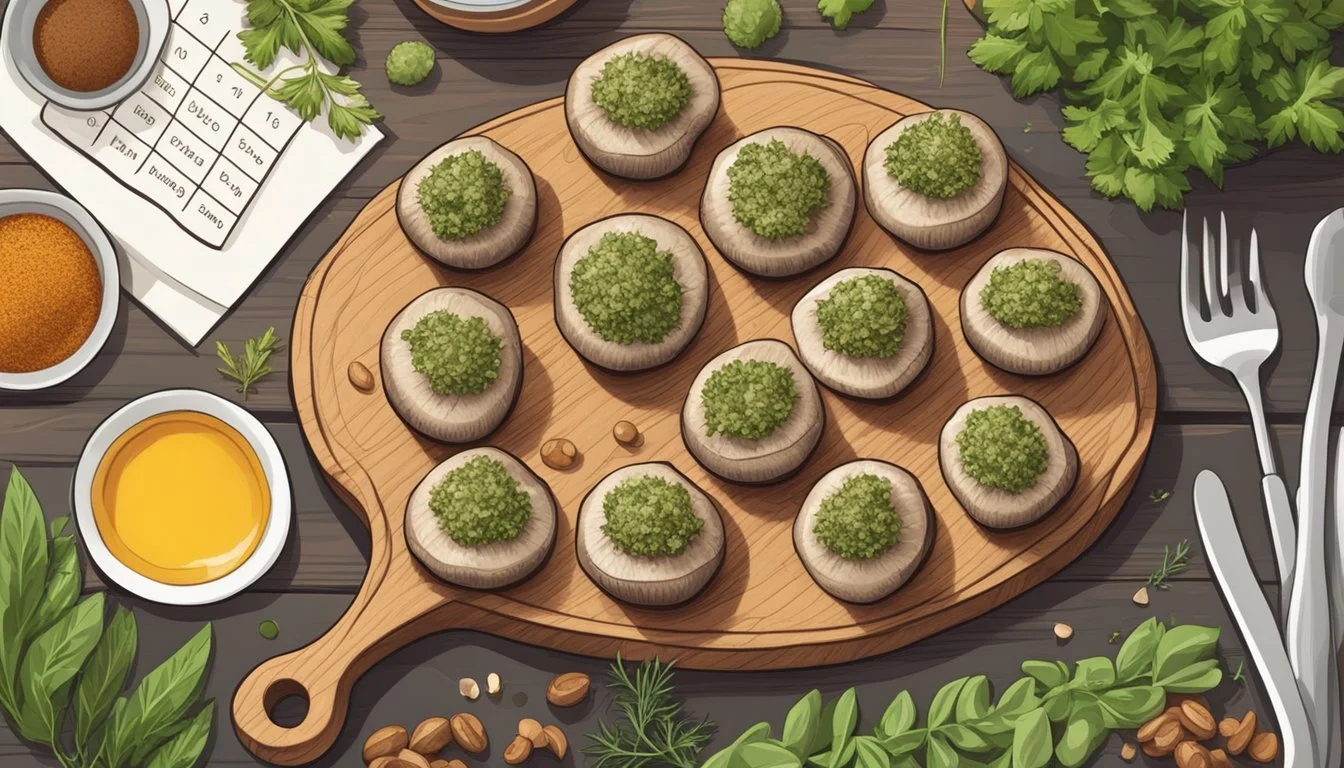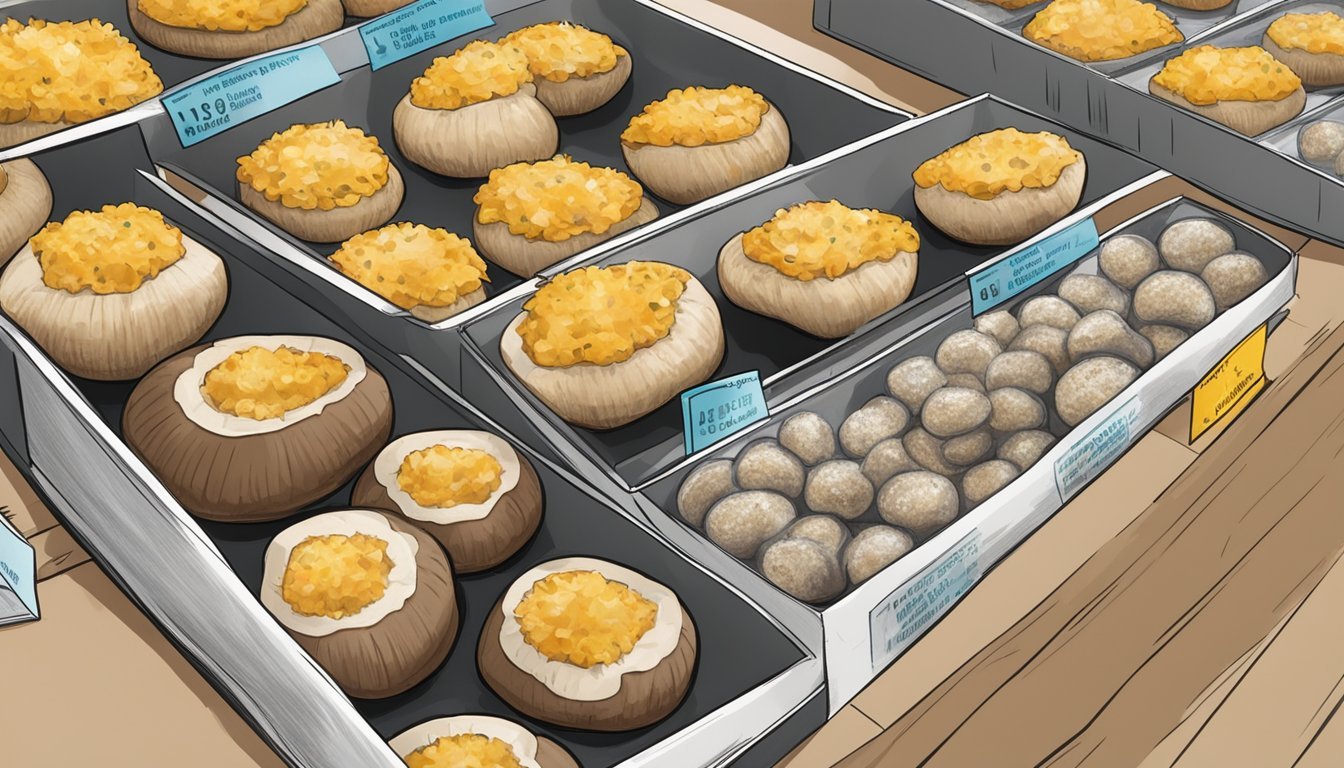How Long Do Gluten-Free Stuffed Mushrooms Last?
Shelf Life and Storage Tips
Gluten-free stuffed mushrooms make for a versatile and delicious appetizer that is perfect for various occasions. When prepared correctly, these savory treats can safely be stored and enjoyed later. Gluten-free stuffed mushrooms can last in the refrigerator for up to 3-4 days.
Proper storage is key to maintaining their quality. Place the cooled mushrooms in an airtight container before refrigerating. For those planning to keep them longer, freezing is an option. However, the texture might change slightly upon thawing and reheating.
Understanding the best practices for storage ensures that your gluten-free stuffed mushrooms remain fresh and flavorful. With basic refrigeration and mindful reheating, you can enjoy this delightful appetizer over several days without compromising on taste or safety.
Gluten-Free Stuffed Mushrooms Overview
Gluten-free stuffed mushrooms provide a delicious option for those adhering to gluten-free diets. These appetizers blend a variety of flavorful ingredients while catering to dietary restrictions.
Understanding Gluten-Free Diets
A gluten-free diet excludes the protein gluten, found in grains such as wheat, barley, and rye. It is essential for individuals with celiac disease or gluten sensitivity. Gluten can damage the small intestine in those with celiac disease, leading to serious health issues.
People on gluten-free diets focus on whole foods like fruits, vegetables, and proteins. Incorporating gluten-free breadcrumbs and ensuring all ingredients are free from gluten contamination are key steps in creating safe and delicious recipes.
Selecting the Right Ingredients
Choosing the right ingredients is crucial. Mushrooms, particularly baby bellas, are a popular base for this dish. For the stuffing, a combination of gluten-free breadcrumbs, cream cheese, and Parmesan cheese adds flavor and texture.
Garlic, spinach, and artichokes are often included for their taste and health benefits. Select olive oil for sautéing and blending ingredients smoothly. Items like bacon and eggs can be added for extra richness, while keeping in mind any additional dietary restrictions. By meticulously selecting gluten-free products and fresh ingredients, one can ensure both safety and flavor continuity in the recipe.
Preparation Techniques
To prepare gluten-free stuffed mushrooms, there are several key steps to follow to ensure a delicious and safe dish. These steps include cleaning and prepping the mushrooms, proper baking techniques, and choosing the right stuffing and seasoning flavors.
Cleaning and Prepping Mushrooms
Start by carefully cleaning the mushrooms using a dry paper towel to gently brush off any dirt from the mushroom caps and stems. Avoid rinsing the mushrooms under water, as they can absorb moisture and become soggy.
Next, remove the stems by gently twisting and pulling them out from the caps. Mince the removed stems to use in the stuffing. If needed, use a spoon to scoop out any remaining pieces from the inside of the caps, creating a hollow space for the stuffing.
Baking and Cooking Tips
Preheat the oven to the specified temperature based on the recipe, commonly either 350°F or 400°F, as seen in various recipes. Line a baking sheet with parchment paper or aluminum foil sprayed with non-stick cooking spray.
Place the mushroom caps, hollow side up, on the prepared baking sheet. Bake for about 20 minutes or until the mushrooms are tender and the stuffing is golden brown. Ensure even cooking by checking the mushrooms halfway through and rotating the baking sheet if necessary.
Stuffing and Seasoning Flavors
For gluten-free stuffing, use ingredients that provide a flavorful blend and adhere to dietary restrictions. Common ingredients include gluten-free bread crumbs, minced garlic, and diced mushroom stems.
Vegan options might use sautéed vegetables or a mixture of beans and herbs. For non-vegan options, sausage or cheese can add a delicious twist. Season the stuffing with spices like dried basil, fresh parsley, thyme, salt, and black pepper. Mix the ingredients well to ensure each mushroom cap is evenly stuffed with the flavorful mixture.
Using a small spoon, fill each mushroom cap generously with the stuffing, pressing down lightly to compact it. Adjust seasoning as needed before baking, ensuring each bite is packed with flavor.
Storage and Shelf Life
Gluten-free stuffed mushrooms require careful attention to storage to maximize their durability and ensure safety. The methods of refrigeration and freezing vary slightly but provide options to prolong their shelf life effectively.
Refrigeration Guidelines
To refrigerate gluten-free stuffed mushrooms, first cool them to room temperature. Then place them in an airtight container to maintain their freshness.
Stored at or below 40°F (4°C), these mushrooms can last in the fridge for three to four days. Avoid keeping them at room temperature for extended periods to prevent bacterial growth.
Utilize a crisper drawer if available, as this area often maintains optimal humidity for mushrooms' durability. Keep an eye on their appearance and smell; any signs of spoilage like sliminess or off-odors indicate they should be discarded.
Freezing and Reheating Methods
For longer storage, freezing is an excellent option. Freeze gluten-free stuffed mushrooms before cooking for best results. Arrange them on a baking sheet in a single layer and freeze until firm.
Once frozen, transfer them to a freezer-safe bag or container. Label with the date to track their shelf life; they can last up to two to three months.
When ready to reheat, thaw in the refrigerator overnight, then bake or microwave as needed. To reheat in the oven, bake at 350°F (175°C) until heated through. If using a microwave, heat on low power to avoid ruining texture.
Safety and Freshness Tips
Always check for signs of spoilage before consuming stored gluten-free stuffed mushrooms. Look for discoloration, unusual odors, or changes in texture.
Maintain proper food safety practices by keeping storage areas clean and ensuring containers are airtight. This helps in preventing cross-contamination and moisture buildup, which can spoil the mushrooms faster.
Label containers with storage dates to avoid exceeding recommended shelf life, and consume within the recommended time frame to ensure safety and taste quality. Regularly monitor your stored mushrooms to prevent any potential health risks.
Serving Gluten-Free Stuffed Mushrooms
Serving gluten-free stuffed mushrooms involves thoughtful pairings and visually appealing presentation. These versatile appetizers can fit into a variety of meal settings, enhancing the dining experience.
Appropriate Pairings and Courses
Gluten-free stuffed mushrooms are excellent as an appetizer or side dish for a range of occasions. They pair well with fresh salads and light soups, making them ideal for a holiday appetizer or a potluck.
During a Super Bowl party, serve them alongside other finger foods. For a more formal setting, such as a holiday meal, they complement entrees like roast chicken or grilled fish. Their versatility allows them to be included in both casual and formal menus.
Presentation and Garnishing
To enhance the visual appeal, arrange the stuffed mushrooms on a platter with garnishes such as fresh herbs like parsley or chives. For added color, try sprinkling pomegranate seeds or cherry tomato halves around the platter.
Using a linen napkin under the mushrooms can add an elegant touch. Place them hole-side up to showcase the filling, ensuring each piece remains intact and appetizing. The thoughtful presentation helps elevate the dining experience, making the dish both visually pleasing and delicious.
Dietary Considerations and Variations
Understanding dietary needs and preferences is crucial when preparing gluten-free stuffed mushrooms. The right substitutions can cater to different diets and allergies, enhancing the recipe's versatility.
Vegetarian and Vegan Options
For vegetarian versions, traditional recipes already fit the bill. Standard fillings like mozzarella cheese, Romano cheese, and cream cheese are common.
For a vegan variation, replace dairy cheeses with plant-based alternatives. Vegan cream cheese and mozzarella made from nuts or soy are excellent options. Using nutritional yeast can add a cheesy flavor without any dairy.
In addition to cheese substitutes, consider adding chopped nuts or tofu for extra protein and texture. By making these adjustments, one can enjoy a flavorful dish while adhering to vegan dietary restrictions.
Alternatives for Common Allergens
To accommodate those with dairy allergies or lactose intolerance, swap out cream cheese and mozzarella with dairy-free alternatives. There are various lactose-free cheeses available that mimic the texture and taste of traditional cheeses.
For soy allergies, choose soy-free plant-based options. Nut-based cheeses, such as those made from cashews, offer a creamy texture without soy. Check ingredient labels to avoid hidden allergens and ensure the replacements fit dietary needs.
Those with nut allergies should avoid tree-nut-based cheeses, turning instead to seed-based or coconut-based options. By substituting appropriately, these stuffed mushrooms remain safe and enjoyable for all.
Adjusting for Taste and Texture
Preferences for taste and texture can vary widely. Adjusting ingredients allows a more personalized dish. For a heartier filling, add finely chopped vegetables like bell peppers or spinach. These add nutritional value and depth of flavor.
Experiment with different herbs and spices. Adding fresh basil, thyme, or oregano can enhance the richness and add an aromatic quality.
To adjust the texture, consider the type of breadcrumbs used; gluten-free panko breadcrumbs provide a crunchier bite compared to standard gluten-free breadcrumbs. For a creamier filling, increase the quantity of cream cheese or its plant-based substitute.
By fine-tuning ingredients, one can create a custom, satisfying experience regardless of specific dietary preferences.
Cultural and Seasonal Adaptations
Gluten-free stuffed mushrooms can be tailored to fit a variety of cultural traditions and seasonal gatherings. This versatility makes them a popular choice for many occasions.
Traditional Holiday Varieties
During Thanksgiving and Christmas, gluten-free stuffed mushrooms serve as a delightful appetizer. In American households, flavors familiar to these holidays, such as turkey and mashed potatoes, can be incorporated into the stuffing. Gluten-free breadcrumbs mixed with turkey, sage, and a bit of cranberry provide a festive touch.
Common stuffing ingredients also include Italian sausage, which pairs well with the holiday spirit given its savory and versatile profile. For those who prefer vegetarian options, adding artichoke hearts and a blend of cheeses can create a rich and flavorful stuffing without meat.
Global Cuisine Inspirations
Stuffed mushrooms inspired by global cuisines allow for cultural diversity in your culinary experiences. For instance, Italian-style gluten-free stuffed mushrooms might feature ingredients like mozzarella, sun-dried tomatoes, and basil. This Mediterranean twist creates a fresh and vibrant option for gatherings.
Asian-inspired versions could incorporate gluten-free soy sauce, ginger, and scallions, offering a unique and savory flavor profile. Button mushrooms are ideal for these adaptations, as they readily absorb these diverse flavor combinations while maintaining their shape and texture.
By adapting recipes to reflect different cultural cuisines, gluten-free stuffed mushrooms can elevate any meal, providing both familiar and exotic tastes suited to any celebration or season.








